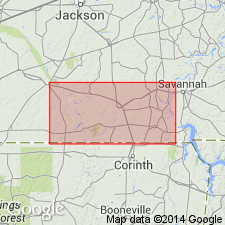
- Usage in publication:
-
- Coffee sand
- Modifications:
-
- Named
- Dominant lithology:
-
- Sand
- AAPG geologic province:
-
- Upper Mississippi embayment
Summary:
Name Coffee sand is proposed for the lowest Cretaceous formation in western TN. Name from Coffee Landing, Hardin Co. Unit is a sequence of mostly stratified sands, usually containing mica scales. Thin leaves of dark clay are often interstratified with the sand, the clay leaves occasionally predominating. Sometimes beds of dark laminated or slaty clay 1 to 20 or more ft thick are included. Thickness probably 200 ft. Northern extension of Tombigbee sand of Hilgard, which most likely ought to be included in his Eutaw group. Underlies Cretaceous Green sand or shell bed [Selma chalk of later reports.]
Source: GNU records (USGS DDS-6; Reston GNULEX).
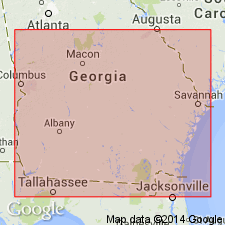
- Usage in publication:
-
- Coffee sand member*
- Modifications:
-
- Revised
- Areal extent
- AAPG geologic province:
-
- Upper Mississippi embayment
Summary:
Coffee sand in TN and Tombigbee sand in MS revised as members of the Eutaw formation--the upper called Coffee sand member of Eutaw formation, and the lower called Tombigbee sand member of the Eutaw. Tombigbee sand member overlies thick, undifferentiated deposits of the Eutaw. Coffee sand member grades laterally into lower part of Selma chalk in MS and is also overlain by upper part of Selma chalk. The Coffee sand is not present in AL. The Coffee sand of early AL reports is included in Tombigbee sand member and underlying beds of Eutaw formation.
Source: GNU records (USGS DDS-6; Reston GNULEX).
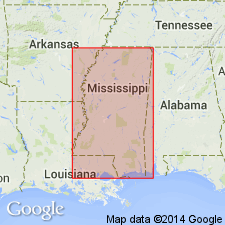
- Usage in publication:
-
- Coffee sand member*
- Modifications:
-
- Revised
- AAPG geologic province:
-
- Black Warrior basin
Summary:
Tupelo tongue of the uppermost part of Coffee sand member of Eutaw formation named in this report. The Tupelo overlies Mooreville tongue of Selma chalk and underlies a large body of Selma chalk. The Tupelo is composed of dark-gray, chiefly massive calcareous, glauconitic sand, 100 ft thick, and extends for about 100 mi in Lee Co., northeastern MS.
Source: GNU records (USGS DDS-6; Reston GNULEX).

- Usage in publication:
-
- Coffee sand*
- Modifications:
-
- Overview
- AAPG geologic province:
-
- Upper Mississippi embayment
Summary:
In a letter dated March 7, 1936, L.W. Stephenson proposed to make the Coffee an independent formation. The Coffee sand, then, is considered a distinct formation and the Eutaw formation is restricted to beds between the top of the Tombigbee sand member and the top of the underlying Tuscaloosa Formation.
Source: GNU records (USGS DDS-6; Reston GNULEX).
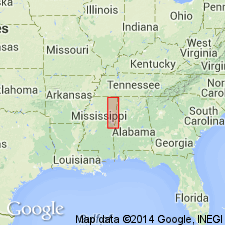
- Usage in publication:
-
- Coffee sand*
- Modifications:
-
- Areal extent
- Overview
- AAPG geologic province:
-
- Black Warrior basin
- Upper Mississippi embayment
Summary:
Unit crops out in MS in belt about 10 mi wide west of Eutaw formation and east of Selma chalk except in central Lee Co. where it intertongues and merges with lower part of Selma chalk. Includes Tupelo tongue. Average thickness about 200 ft in Prentiss and Alcorn Cos.
Source: GNU records (USGS DDS-6; Reston GNULEX).
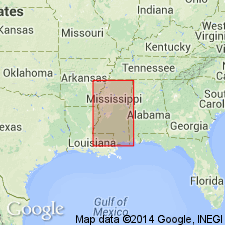
- Usage in publication:
-
- Coffee sand
- Modifications:
-
- Revised
- AAPG geologic province:
-
- Black Warrior basin
- Upper Mississippi embayment
Summary:
Coffee sand included in Selma group. [Age is Late Cretaceous.]
Source: US geologic names lexicon (USGS Bull. 1200, p. 872).
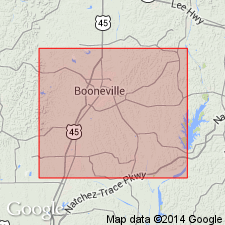
- Usage in publication:
-
- Coffee sand*
- Modifications:
-
- Overview
- AAPG geologic province:
-
- Black Warrior basin
Summary:
Formation described in Prentiss Co., MS, where it is about 27 ft thick. Disconformably overlies Tombigbee sand member of Eutaw formation; conformably underlies Demopolis formation. Age is Late Cretaceous.
Source: GNU records (USGS DDS-6; Reston GNULEX).
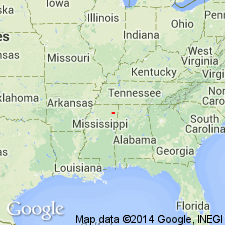
- Usage in publication:
-
- Coffee Sand
- Modifications:
-
- Overview
- AAPG geologic province:
-
- Black Warrior basin
Summary:
Coffee Sand is an updip terrigenous facies of the Campanian to Maastrichtian Selma Chalk sequence. Unit crops out in a belt extending from the Alcorn-Tishomingo Co. area of northeastern MS southward to central Lee Co, where the sand facies changes to argillaceous chalk. Forms the base of the Selma Group in northernmost MS where the Mooreville Chalk is absent and the Coffee directly overlies the Tombigbee. In this area, the Coffee Sand is predominantly a cross-bedded sand with occasional thin clay beds and some burrowed sand intervals. Clay component increases in a south and westward direction and the formation becomes more fossiliferous, especially in the lower part.
Source: GNU records (USGS DDS-6; Reston GNULEX).
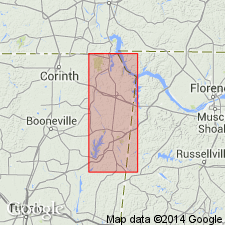
- Usage in publication:
-
- Coffee Formation
- Modifications:
-
- Overview
- AAPG geologic province:
-
- Black Warrior basin
Summary:
Coffee Formation of Selma Group is the uppermost unit of Cretaceous age present in Tishomingo Co., and the only unit representing the Selma. No complete section is present in the report area as the unit is truncated by erosion. It is composed of very fine- to medium-grained, micaceous, glauconitic, quartz sand, thinly interbedded and interlaminated with light- to medium-gray, silty clay. The Coffee is replaced by the main body of chalky Selma strata in southern Lee and northwestern Itawamba Cos. The Tupelo Tongue is a very fossiliferous phase representing the southernmost extension of the Coffee Formation. Outcrop belt attains a maximum width of 8 mi in northwestern part of Tishomingo Co. Thickness is 150 ft at the surface of northwestern Tishomingo Co., 275 ft in Prentiss Co. to the south, and only about 100 ft in Lee Co. Disconformably overlies the Tombigbee Sand Member of the Eutaw Formation; unconformably underlies Tennessee River terrace deposits. Age is Late Cretaceous.
Source: GNU records (USGS DDS-6; Reston GNULEX).

- Usage in publication:
-
- Coffee Sand
- Modifications:
-
- Revised
- AAPG geologic province:
-
- Upper Mississippi embayment
Summary:
A richly fossiliferous interval in the Tupelo Tongue of the Coffee Sand has been exposed in the vicinity of Chapelville, Lee Co., MS. The interval is here informally named the Chapelville fossiliferous horizon. It is estimated to contain between 200 and 300 molluscan species of Campanian age. A complete study will be published as a three-part bulletin series. A measured section of the horizon at the Friendship-Pratt Road locality where it was cored shows the thickness as slightly less than 3 m, or 2 ft greater than observed in the adjacent outcrop.
Source: GNU records (USGS DDS-6; Reston GNULEX).
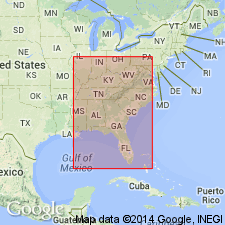
- Usage in publication:
-
- Coffee Sand*
- Modifications:
-
- Biostratigraphic dating
- AAPG geologic province:
-
- Black Warrior basin
Summary:
Coffee Sand shown as Late Cretaceous (Campanian) in fig. 1. Early and late Campanian age based on CRASSATELLA HODGEI collected from Prentiss and Lee Cos., northern MS.
Source: GNU records (USGS DDS-6; Reston GNULEX).

- Usage in publication:
-
- Coffee Sand*
- Modifications:
-
- Biostratigraphic dating
- Areal extent
- Revised
- AAPG geologic province:
-
- Illinois basin
- Upper Mississippi embayment
Summary:
Coffee Sand conformably overlies Post Creek Formation (new name) and unconformably underlies McNairy Sand in Benton Hills core, Pulaski Co., southern IL. Based on age, stratigraphic position, and lithologic similarity, unit can be correlated with type Coffee Sand of Safford (1864) in TN. Sample in IL yielded pollen specimens of PROTEACIDITIES spp., EXTREMIPOLLIS VERSATILIS, OSCULAPOLLIS AEQUALIS, O. PERSPECTUS, CHOANOPOLLENITES CONSANGUINEUS, C. TRANSITUS, TRUDOPOLLIS sp. A of Tschudy (1975), and "RETITRICOLPITES" sp. H of Frederiksen and others (1982), as well as other taxa. Presence of these species in combination with PSEUDOPLICAPOLLIS SERENA suggests late Campanian to perhaps early Maastrichtian age, which is consistent with age proposed by Tschudy (1975) for type Coffee Sand. This occurrence is an outlier of Coffee Sand, separated from main body of Coffee Sand in western TN. IN MO, all marine sandstones elsewhere in subsurface of Mississippi embayment below stratigraphic level of McNairy Sand are considered part of Coffee Sand. Coffee Sand and other deposits of Campanian age are absent from southern IL, Jackson Purchase region of western KY, and New Madrid area.
Source: GNU records (USGS DDS-6; Reston GNULEX).
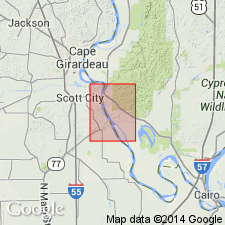
- Usage in publication:
-
- Coffee Sand*
- Modifications:
-
- Overview
- Areal extent
- AAPG geologic province:
-
- Illinois basin
- Upper Mississippi embayment
Summary:
Coffee Sand mapped undivided with Owl Creek Formation, McNairy Sand, and Little Bear Formation in MO and IL. Consists of silty to sandy clay and gravel. Crops out only in a few places in quad, mostly along Mississippi River bluffs. Name assigned to rocks previously called Coon Creek Formation by McQueen and Weller (1939), but from descriptions of Cretaceous sediments in Upper Mississippi embayment by Pryor (1960), more closely resembles Coffee Formation.
Source: GNU records (USGS DDS-6; Reston GNULEX).
For more information, please contact Nancy Stamm, Geologic Names Committee Secretary.
Asterisk (*) indicates published by U.S. Geological Survey authors.
"No current usage" (†) implies that a name has been abandoned or has fallen into disuse. Former usage and, if known, replacement name given in parentheses ( ).
Slash (/) indicates name conflicts with nomenclatural guidelines (CSN, 1933; ACSN, 1961, 1970; NACSN, 1983, 2005, 2021). May be explained within brackets ([ ]).

